I’ve read an awful lot of fantasy, and watched an awful lot of anime, and both canvases are incredibly broad and notoriously hard to characterize.
When first discussing this essay, comparing and contrasting the traditional hero narrative in fantasy fiction and anime, with my friend Casey Blair, I found myself in a bit of difficulty. I’ve read an awful lot of fantasy, and watched an awful lot of anime, and both canvases are incredibly broad and notoriously hard to characterize.
Fantasy, after all, includes classics like Lord of the Rings, heroic secondary-world epics like The Wheel of Time, wainscot fantasy like Harry Potter, and the magical realism of The City & The City, covering sub-genres like urban fantasy and steampunk in between. It’s very hard to write a coherent comparison that covers both C.S. Lewis’ The Chronicles of Narnia and Max Gladstone’s Three Parts Dead, for all that we shelve them in the same genre.
Similarly, anime is unbelievably diverse, more so than all but the most hardcore of fans realize. (Because the US translation companies skim the cream of the crop, picking the hit shows and often passing over the stuff with less broad appeal.) From staples like Dragonball, Sailor Moon, or Naruto, anime goes all the way to Revolutionary Girl Utena (which is so symbolic as to be almost abstract) and Non Non Biyori (which is about a bunch of girls in a rural village chatting about nothing in particular). It includes every genre of speculative fiction we have in the US, and some we don’t.
All this makes generalizations a bit difficult, so, for the purposes of this essay, we need to narrow the field a little. I’d like to compare a particular popular strain in epic fantasy with a particular style of shounen anime. On the fantasy side, you might think of it as the “farmboy who saves the world” story, though there’s usually more to it than that. It includes The Wheel of Time, The Belgariad, The Chronicles of Prydain, Harry Potter, and many, many others. Veteran fantasy readers should recognize the tropes more or less immediately.
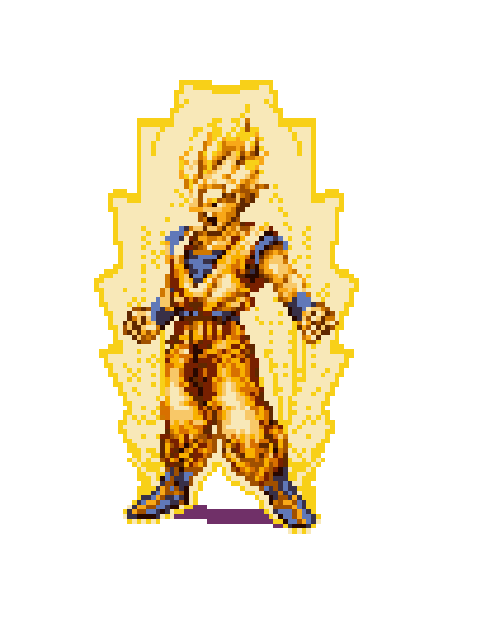
“Shounen,” in an anime context, describes a show primarily intended for a young male audience, or one deriving from comics running in magazines aimed at that same audience. They include a lot of the shows most familiar to American audiences: Dragonball is a classic shounen anime, as is Naruto, Bleach, Inuyasha, Hunter x Hunter, Rurouni Kenshin, and again too many others to list.
These two sub-genres have a great deal in common. They tell, in essence, similar stories: the tale of the rise of a hero and his (almost always his, which we’ll touch on later) growth in power and confidence. This growth is a critical component of the story arc; other genres may feature protagonists who get more powerful as the series goes along, but in this style of epic fantasy that journey is essentially the point of the series. (Note that this means The Lord of the Rings doesn’t qualify! Frodo grows as a character, but he’s still a hobbit; compare that to the arcs followed by Rand al’Thor or Harry Potter over the course of their series.)
The critical difference between the epic fantasy and the anime approach, however, has to do with the main character’s motivation. Epic fantasy protagonists almost always have their destiny imposed on them from the outside; left to themselves, they either would not want to be part of great events or are unaware that such things are even possible. (Rand and Harry, respectively.) The reason that the Beloved Peasant Village (and its subsequent destruction by the Forces of Evil) is a well-worn trope is that the epic fantasy protagonist needs a kick to get him moving on the greater things. Joseph Campbell’s Hero’s Journey often describes this kind of story very well.
Shounen anime protagonists, on the other hand, tend to be self-motivated. If they start out in a peasant village, they’re almost always planning to escape from the confines of a provincial life and embark on an adventure. They have something they want — power, revenge, knowledge, riches — and it is this unstoppable drive that makes them the hero. While a large part of the arc is the same, this difference makes the ultimate story very different.
(Caveat: My conscience forces me to add that of course I am not describing all epic fantasy or all shounen anime here. Even sub-genres are huge, and counter-examples can be found to anything. I only want to talk in very general terms to illuminate a few interesting contrasts.)
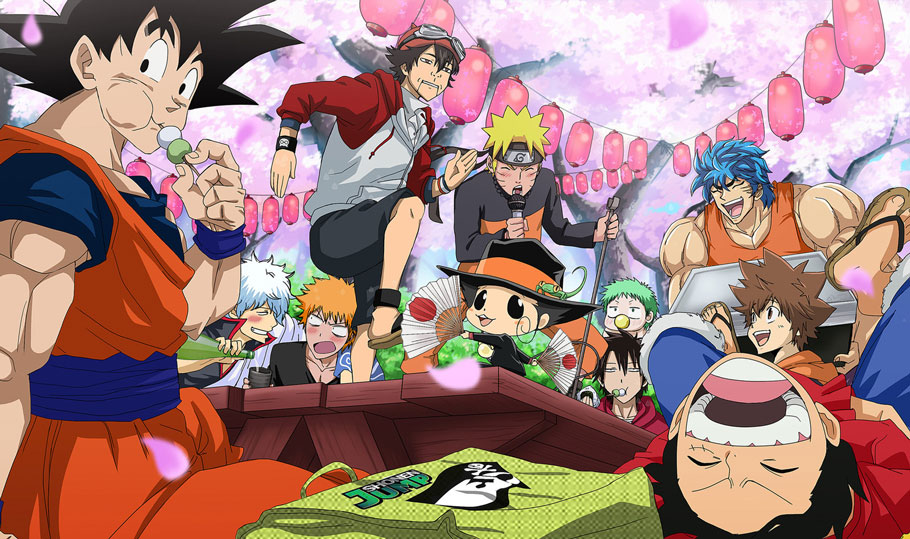
Art by Giorgia Lenzi
Heroes: Where do they come from?
Both epic fantasy and shounen anime heroes are usually of humble origins, almost always in the lowest available position relative to his peers.
Both epic fantasy and shounen anime heroes are usually of humble origins. The epic fantasy hero is, in the classic version, the orphan farmboy unaware of his destiny, and sometimes of his own origins. Rand al’Thor grew up in a tiny village, and Harry Potter lived under the stairs. Other “orphans” turn out to be princes, scions of ancient dynasties, or heirs to great warrior traditions.
On the shounen anime side, the hero almost always begins in the lowest available position relative to his peers. Sometimes this is pretty similar to the fantasy style; Luffy from One Piece is a penniless vagabond, Goku from Dragonball is an orphan. Sometimes an ordinary human, like Ichigo from Bleach, gets sucked into a world where ordinary humans are cannon fodder. Naruto lives in a ninja village, but among ninja he’s still at the bottom of the pecking order, and similarly Inuyasha, as a half-demon, is reviled by humans and demons alike.
This makes a lot of sense, story-wise. Since the basic arc of the story is the character’s gain of power and ability, they need to start from a fairly low point. Because they also gain knowledge along with the viewer, they tend to start out being pretty ignorant of the “real world” in which the story takes place — either the world outside the village, the world of magic, or what have you. This also means they’re young (sometimes very young) and inexperienced. More on this below.
Who are they?
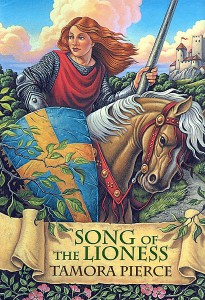
Buy the Song of the Lioness Quartet by Tamora Pierce: Book
Typically, the main characters of this kind of story are crafted to be easy for the audience to identify with. (This also means you can see the assumed audience by looking at the main character.) They tend to be in their late teens (though the anime heroes are younger), male, and not particularly distinguished in terms of skills or abilities. The age, as I mention above, is both to put them on a level with the reader and to provide a convenient reason why they don’t know anything about the world. Their lack of skill, like their lack of status, gives them a low base to begin their arc.
Shounen magazines are for boys, and clearly marked as such, while their counterpart shoujo (girls) magazines run very different stories.
It’s a bit harder to say why they tend to be male, since the answer has more to do with demographic trends among readers/viewers and institutional sexism in the industry, which is a bit outside the scope of this article. On the anime side, shows (and comics) are strongly segmented by their target demographic, especially for teens — so shounen magazines are for boys, and clearly marked as such, while their counterpart shoujo (girls) magazines run very different stories. In epic fantasy, the stranglehold of boys on this kind of story seems to be breaking up at last, but there’s a long way to go. Suffice to say, there’s no intrinsic reason why the hero should be male (since these are usually not stories about gender) but he traditionally has been, with a few welcome exceptions. (Tamora Pierce’s The Lioness Quartet springs to mind.)
What makes them special?
This is where we start to get at the essential contrast between the two sub-genres. In epic fantasy, the main character is almost always chosen in some way, shape, or form. Sometimes he is the unwilling recipient of power he doesn’t understand, sometimes he is the subject of a prophecy, sometimes he is marked from birth as special in the eyes of the gods. However it happens, the hero is in a class of his own from the beginning, although it may take some time to recognize it as such. This rarely provides any immediate benefit, however — any powers are unreliable or quixotic, and being prophesized to defeat the Dark Lord doesn’t make actually defeating him any easier.
The shounen anime protagonist, on the other hand, is usually not marked out, at least among his potential peers. He may have something that sets him apart from ordinary people, but so do many others, and there’s nothing that makes him particularly worthy of note. Instead, he is separated by his intrinsic drive, a goal that pushes him to work harder, train longer, and generally never give up.
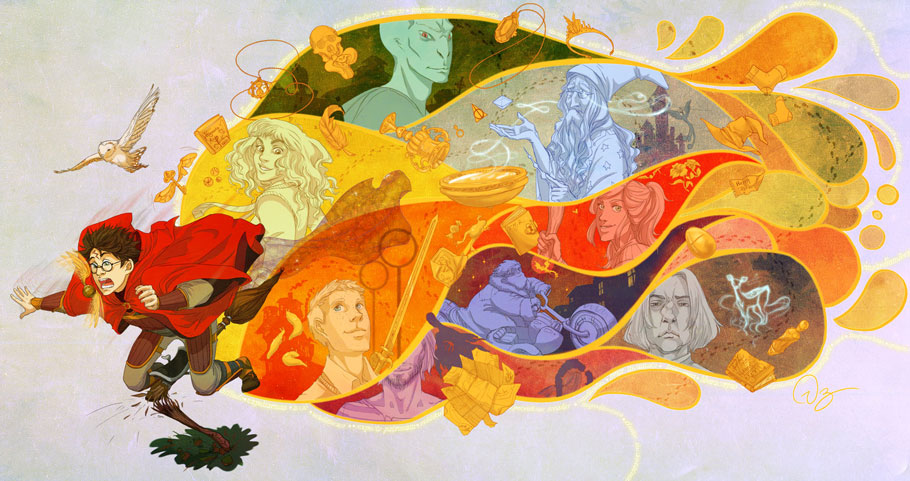
Art by palnk
So Rand al’Thor is the Dragon Reborn whether he wants to be or not — he inherits a destiny, along with unbelievable power and a nasty set of problems.
So Rand al’Thor is the Dragon Reborn whether he wants to be or not — he inherits a destiny, along with unbelievable power and a nasty set of problems. Harry Potter is the Boy Who Lived, whether he knows it or not. Goku, by contrast, is an alien, but far from the biggest or baddest alien. Ichigo gains shinigami powers, but he’s still out-ranked by a whole organization. Maka from Soul Eater (a very rare female example, even if she has to share main character status) attends a whole school for Meisters. The anime characters almost always have the option to sit back, to not adventure, to let someone else handle it, while the epic fantasy characters are dragged kicking and screaming into their fates.
Who teaches them?
Mentors feature heavily in both epic fantasy and shounen anime, as one might expect of stories that are mostly about watching a character’s knowledge and power grow. Because of the difference in motivation, though, the mentors serve different roles in the story.
The epic fantasy mentor is usually the element that gets the story started. He or she arrives in town, often just ahead of the villains, and spirits the main character off to begin his quest. If these characters need to be dragged into their roles, it’s usually the mentor who does the dragging. As the quest goes on, the mentor teaches the hero; skills, certainly, but more importantly to believe in himself and in his destiny. Dumbledore serves this role for Harry Potter, of course, along with his fellow professors, while Lan and Moiraine get Rand out of the Two Rivers in The Eye of the World.
The anime hero comes by his mentor differently. Because he’s self-motivated, he doesn’t need someone to turn up at his humble village and drag him away. Rather, the mentor is often the object of a quest, usually the first quest the hero undertakes. Playing “Find the Mentor” can be an adventure in itself, as they like to live in inaccessible areas, and once found they usually impose tests and conditions before they agree to train the hero. Rather than the mentor convincing the hero of his destiny, it’s the hero who convinces the mentor that he is worthy of instruction, and is the one to solve whatever problem he’s set out to deal with.

Once acquired, the relationship between the hero and the mentor progresses similarly in both cases. The hero grows steadily in power, though he may not realize it while he under the mentor’s protection. At some point, though, that protection is stripped away, and the mentor leaves. Often — especially on the fantasy side — the mentor dies, though sometimes less than completely convincingly. (Gandalf the Grey being the archetypical example.) Either way, the hero is left to carry on alone, empowered by his training but vulnerable without the guidance of his teacher.
This is familiar but powerful story trope. The feeling of leaving the nest, of operating for the first time without guidance and supervision, is one that most of us have felt at one time or another, and it feels natural in a story centered around the gradual building of a fledgling into a hero. The mentor serves as a surrogate parent, since the actual parents are almost always either dead, absent, or left behind at the beginning of the quest. Surpassing this teacher, and moving on, is a key milestone on the road to heroism that marks the beginning of the transition to truly “adult” status.
Who helps them?
Both the shounen anime hero and the epic fantasy hero usually acquire companions as they go about their quests. This entourage helps the hero through their trials, provide commentary and specialized knowledge, and serve as plot hooks to keep things moving. In most ways they function similarly across the two genres, and in particular, the relationship of the skills of the companions to the skills of the hero is similar.
Roughly speaking, the hero is rarely particularly good at anything. In epic fantasy, the hero begins as a callow youth, without much in the way of knowledge of power, whereas his companions are often either more obviously talented or already have considerable achievements in their fields. The companions will thus fill roles like “the skilled ranger”, “the smart one”, “the healer”, “the swordmaster”, and so on, while the hero doesn’t have anything particularly going for him other than the destiny that makes him the hero.
A shounen hero, on the other hand, usually has at least the potential to be very powerful, and the will to keep on going no matter what. Frequently, though, he can’t harness that power effectively, because he’s a novice at whatever skill it uses. His companions, on the other hand, are talented in some field, but invariably need the protagonist to ultimately solve their problems. This often takes the form of the companions being convinced that the problem is impossible, and ready to give up, while the hero refuses to surrender with the implacable grit that is the essential attribute of the shounen hero.
Returning to our examples, Rand al’Thor takes a lot longer to come into his power than even the other characters who accompany him from the Two Rivers, and initially people like Lan do most of the fighting. It’s only as the story develops, and his power increases, that he outstrips them. (Rand is actually unusual among epic fantasy protagonists in that he spends a lot longer at full power than usual; more typically, the hero achieves his full strength only just before the Final Battle.) Harry Potter immediately acquires Hermione, who is better than him at everything academic or magical, and Ron, who can explain the wizarding world and provide exposition.
Shounen heroes often have much larger entourages, sometimes well into the double-digits of secondary characters. In epic fantasy, companions can be acquired in a variety of ways, but the shounen hero gets his (except for perhaps a few who come with him from home) almost exclusively by fighting them. In the land of the shounen heroes, fighting someone and defeating them is a sure-fire way to get them to join your team, provided you’re generally honorable about it and act kindly towards them afterward. Dragonball alone provides endless examples of this, to the point where Goku’s crew has a majority of former villains.
Who Do They Fight?
This is one area where the two genres differ wildly. Epic fantasy protagonists, going all the back to mythology and The Lord of the Rings, tend to be matched against villains who are the incarnation of pure evil. Creatures like Sauron or The Dark One are the standard here — forces of nature, outside of conventional motivations, who pursue their dark agendas because causing evil is their very nature. Even in Harry Potter, where Voldemort has a human(-ish) face, there isn’t a real attempt to humanize him or provide justification for his actions.
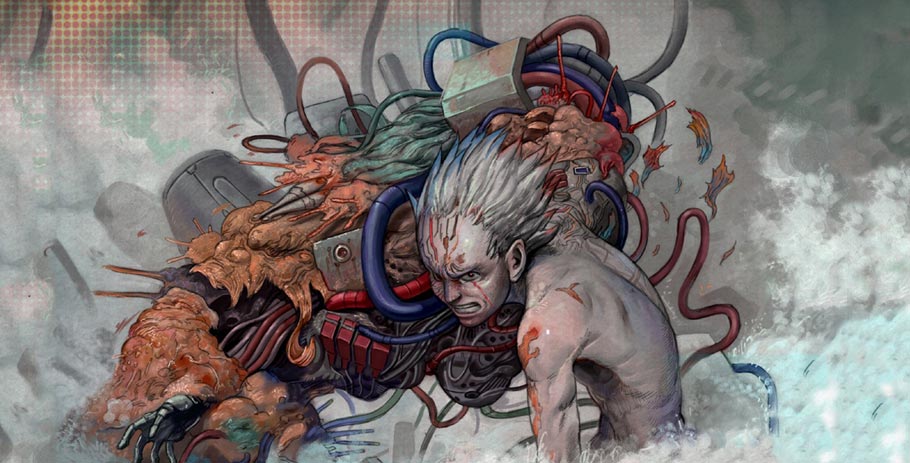
Much more dangerous, and more central to the plot, are the villains who have a coherent(-ish) philosophy and a reason for what they do, although often an ugly one.
The shounen hero, on the other hand, is almost never confronted with pure or mindless evil. The closest he comes to it is villains who are obviously corrupt, greedy, or venal, but those are usually easily disposed of. Much more dangerous, and more central to the plot, are the villains who have a coherent(-ish) philosophy and a reason for what they do, although often an ugly one. Battles between the hero and the villain thus become a comparison of competing ideologies, where the victor is the one who breaks his opponent’s spirit by demolishing his philosophical position. (This is one reason many shounen anime are very “talky”; the other is that talking is cheap to animate.) After the hero is victorious, this often results in the villain joining his team, as discussed above, because he has now been convinced the hero’s philosophy is superior.
Epic fantasy generally retains a fairly clear-cut notion of good and evil as objective, abstract constructs, often physically embodied in the universe. This allows the destiny of the hero to make some kind of sense — a Chosen One who was unsure if he’d been chosen by the right side would not be terribly effective. The readers are rarely intended to be unsure who is in the wrong in any given conflict, at least if the ultimate villain is somehow involved. (This tendency is almost completely reversed in more recent, “grimdark” fantasy and its related sub-genres.)
The shounen world rarely has such obvious moral touchstones, because the point of the hero’s journey is to establish and prove the dominance of his particular set of morals and ideas. This makes it sound more sophisticated than it often is; shounen philosophy is usually pretty basic, and breaks down into things like “you should always help people” vs. “the ends justify the means”. The villains often believe things like “sacrifices are necessary for the greater good” and need to be convinced otherwise by force.
One exception to the rule that shounen villains are humanized and complicated comes at the very end of the story, where the final villain is revealed. Then, sometimes, the previous head villain will join the hero’s side, only to reveal some actual force of “pure” destruction standing behind him. This is convenient, because it allows the hero to fight all-out without moral qualms.
How does it all end?
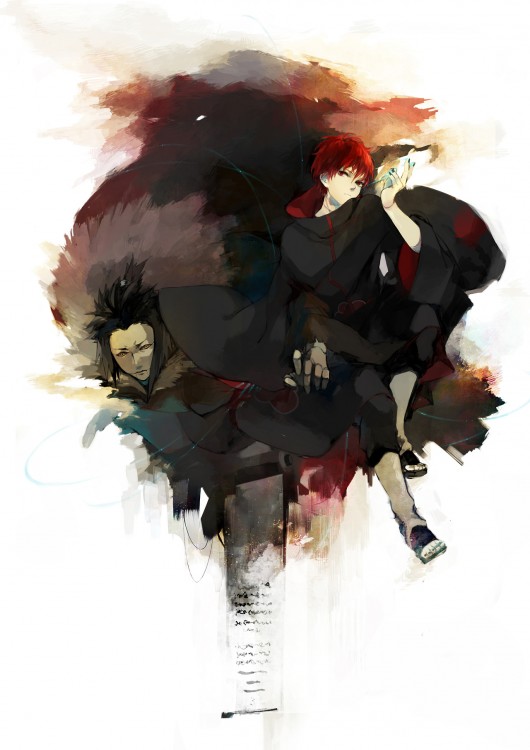
Art by コロッケ・オムラシウ
In epic fantasy, a number of endings are possible. The first is the heroic sacrifice — the hero dies, or is otherwise lost to the world, in order to prevent the final victory of evil. This fits very well into the epic hero’s character arc, since he’s gone from being skeptical of his destiny to accepting it over the course of the story, and his self-sacrifice is the ultimate proof of his acceptance.
If he survives, the hero is changed by his experiences. Joseph Campbell says the hero should return home, but not quite the same as when he left, and that fits the epic fantasy hero’s story nicely. Sometimes he retires, concealing his awesome power and leading a quiet life. Other times, he finds that his newfound knowledge and skill makes him fit to rule his people, particularly if his quest involved overthrowing the previous ruler.
The world needs saving, and at the end of the story it’s been saved, leaving the hero with his destiny discharged.
The unifying factor is that there is an ending, because the epic fantasy hero’s goal is externally imposed and quantifiable. The world needs saving, and at the end of the story it’s been saved, leaving the hero with his destiny discharged. The shounen hero, on the other hand, starts with a self-imposed goal, so his ending is a bit more ambiguous. Sometimes he doesn’t get an ending; he may defeat the primary villain, but that doesn’t mean his story doesn’t at least theoretically go on, questing eternally with his companions.
On the other hand, the shounen hero with a specific goal, like “get revenge for my family”, often finds that completing it is unsatisfying. He may conclude that the goal was never worthwhile in the first place, or that his true objective was something else entirely. Many shounen heroes find that their true happiness comes from the friendship of their companions on the journey, so they may decide to extend things and continue onward.
What Does It All Mean?
The details vary, and the plots vary, but these two genres in essence revolve around some very simple themes. At the root, they are both wish-fulfillment fantasies, but they are constructed in slightly different ways.
The epic fantasy embodies the fantasy of being chosen, being special, being unique. The hero is plucked out of his mundane life to do battle on a larger plane; he struggles there, but eventually proves himself worthy of it.
The shounen hero, on the other, gives us the fantasy that never giving up, never abandoning a goal, will eventually see us through. His determination and faith in himself is his most important attribute, ultimately more powerful than sword-fighting or martial arts.
The common element, the thing that makes these fantasies so powerful and relevant, is that it’s easy for the audience to place themselves at the fantasy’s heart. Very few of us are the sons of kings, after all, or world-renowned swordsmen. But anyone can be plucked from obscurity by destiny. Similarly, while few of us are expert martial artists, we all would like to believe that, if it really came down to it, we could believe in ourselves and our cause and never give up. This is why the hero rarely has extraordinary skills of his own — it would impede our ability to identify with the character. By keeping the hero’s key characteristics to the intangible, his indomitable will or the hand of fate, the fantasy is preserved, and we’re able to slip ourselves into the central role.
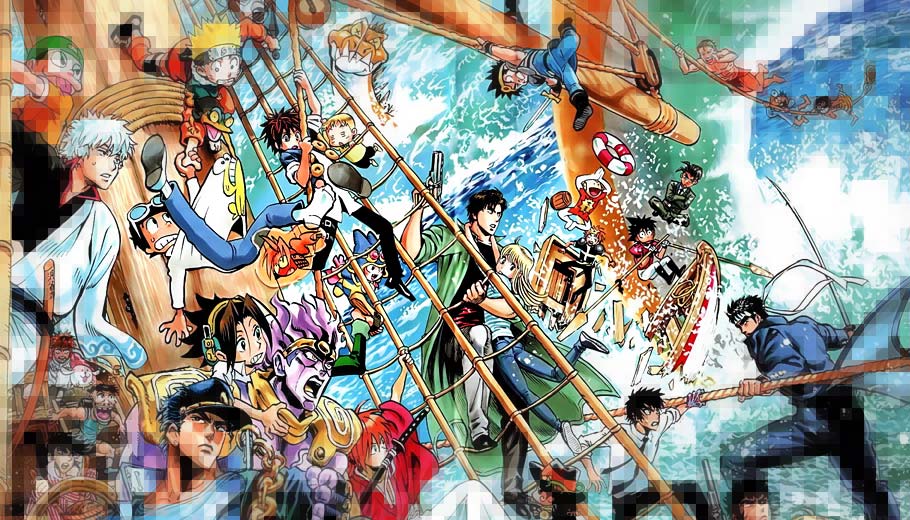
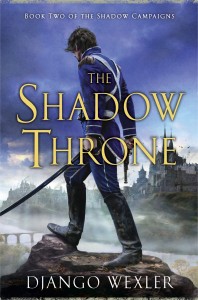


an interesting and fascinating analysis you have here, Django. My own exposure to anime has been relatively light and scattershot, so I can’t really argue knowledgeably with your thesis.
“but anyone can be plucked from obscurity by destiny. ”
I do think that is a big part of the appeal of these kinds of stories, in the end. Reader identification can go very strongly, and very deeply. (And another reason for all sorts of types of protagonists, to give all sorts of people that buy-in)
Agreed, Paul. Especially, I think, because these stories are often aimed at younger readers. The ability to identify with characters very unlike oneself is a learned skill that develops over time.
Indeed, very interesting analysis – and interesting comments. I don’t know much about anime, but as the former geeky teen who was always carrying around at least two novels, I do know something about reader identification, and I agree that the idea that *anyone* can be great given the opportunity, or necessity, is extremely attractive to the typical younger reader of fantasy.
However, as for the ability to identify strongly with characters unlike yourself – any girl who reads a lot (and not just fantasy – consider most of world literature) learns very quickly to identify with male characters. I cannot tell you how excited I was when I discovered Tamora Pierce – and I am so glad you mentioned her in this article. Another one like it was Robin McKinley’s The Blue Sword – girl gets put in a situation where determination, work, and a bit of luck and magical assistance let her be her own hero. But generally, the choice for girls is either to identify with male protagonists, which is at that age perhaps the most unlike oneself that it gets, or choose Jane Eyre, Hester Prynne, etc – or rather, their fantasy/YA chick lit counterparts. Nothing wrong with those, but they are not exactly inspirational… Thankfully, there has been a lot of improvement on this lately. I thought it interesting that apparently, quite a lot of boys read The Hunger Games and co., as long as the covers aren’t too ‘girly’.
SO I can only second the statement that there should be all sorts of protagonists, but not only to give all sorts of people buy in, but also to give all sorts of people practice in identifying with others.
Btw. is this kind of hero what you had in mind with Winter? Put by accident in a position where she has to take responsibility, and living up to the challenge with flying colors… I guess I’m no longer that young, but still a sucker for that kind of thing :-)
As I said above, I think identifying with people very unlike oneself is a learned skill, and I’m not surprised girls have to learn it early. (A lot of men apparently never learn, judging from the bitching and moaning that you see on the internet.) I think of Thousand Names as aimed a bit older, so Winter isn’t specifically tapped by destiny, but there’s definitely something of that in there.
My MG fantasy, The Forbidden Library, is *definitely* playing with these tropes though. The basic idea is that you’ve got Alice, the protagonist, and she finds a mentor and is told she’s special and chosen, but she’s given good reason to believe that the mentor doesn’t actually have her best interests at heart. It always kind of bugged me in Harry Potter that, if we weren’t totally sure Dumbledore was a good guy, he’s always doing things that are kind of questionable. (Like sending kids into mortal danger with no warning.) http://djangowexler.com/forbidden-library/
Eeek, that came out wrong – I didn’t mean to imply that Thousand Names was aimed at younger readers, rather to agree that the ‘some have greatness thrust upon them’ motif, whether by destiny or, more adult-ly, by circumstance, creates a great deal of character appeal for all ages…
*runs off to continue reading The Shadow Throne, obviating the need to run off to join the army and have painful adventures myself*
Haha, no worries! I definitely agree with you there.
An interesting comparison–now that you mention all this stuff, a lot more examples are coming to mind.
Being cynical for a moment, one reason that a shounen protagonist never actually reaches the end of the story is probably because manga is a serial format and there’s a commercial incentive to just continue forever.
Regarding identification with the protagonist: Japan in general seems to have a major cultural current of success coming through pure effort. So perhaps a protagonist that more explicitly embodies that ethic would be more generally appealing in Japan.
Hmm, actually, it occurs to me that the protagonist motivation difference you point out is reflected in miniature in the Japanese word “ganbatte”. It literally means “work hard!” but is used like an English-speaker would use “good luck!”. The Shounen protagonist gets through with effort and grit; the Epic protagonist gets through on fate and (at least initially) a significant amount of luck.
[…] fantasy and anime fans might be interested in this comparison of epic fantasy and shounen anime – one about heroes summoned by an external call, the other about heroes driven (or so argues […]